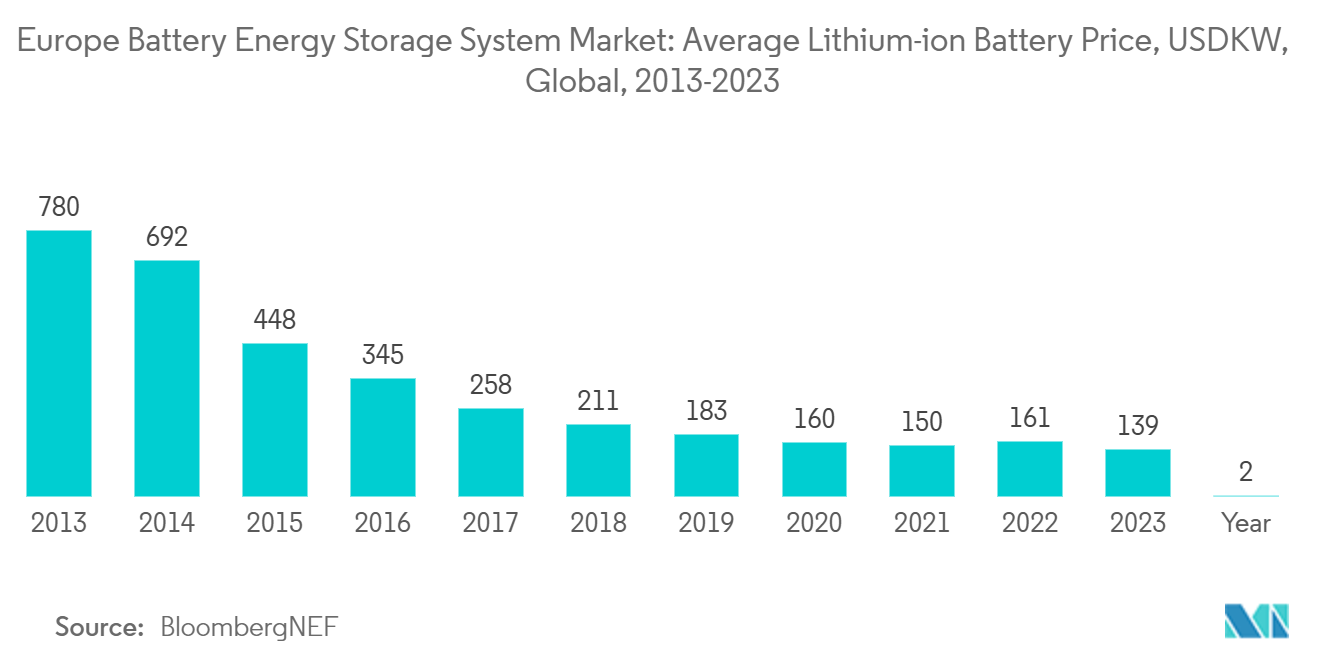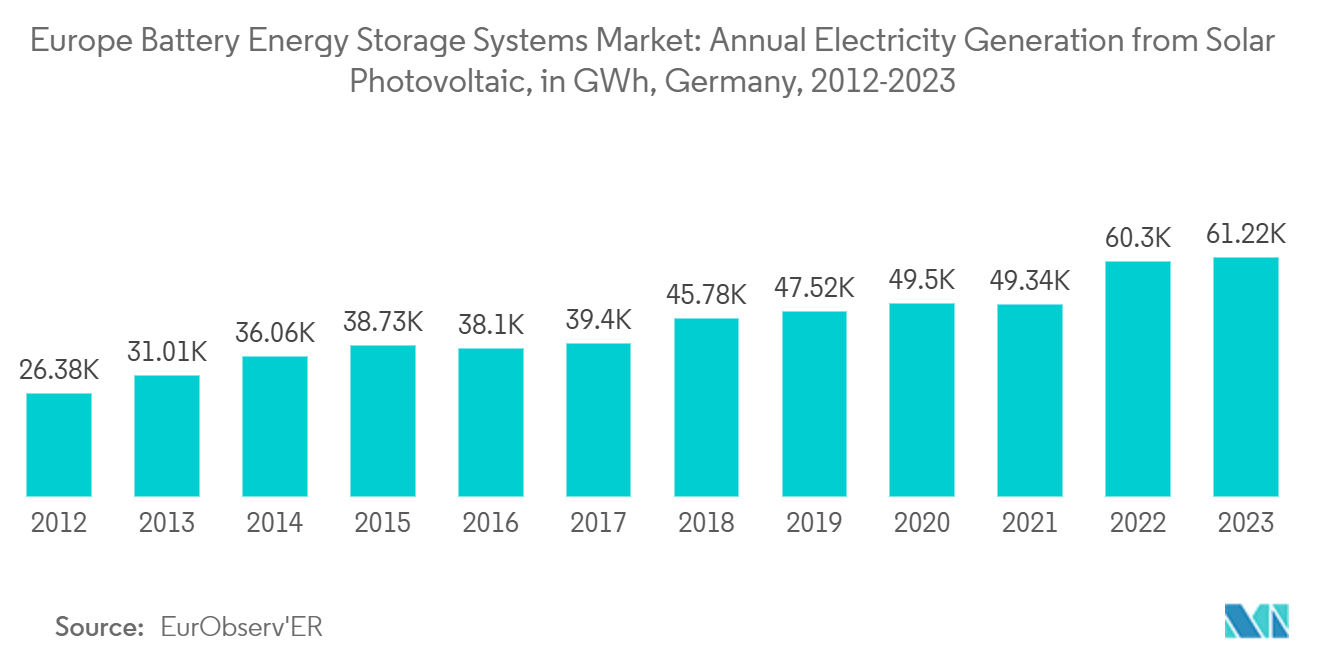Market Trends of Europe Battery Energy Storage System Industry
Lithium-ion Segment Expected to Dominate the Market
- Lithium-ion (Li-ion) batteries are nearly 100% efficient in charge and discharge, allowing the same ampere-hours in and out. These batteries offer various technical advantages over other technologies, such as lead-acid batteries. Rechargeable Li-ion batteries, on average, offer cycles more than 5,000 times, compared to lead-acid batteries that last around 400-500 times.
- Li-ion batteries can be recharged numerous times and are more stable. Furthermore, they tend to have a higher energy density, voltage capacity, and lower self-discharge rate than other rechargeable batteries. This improves power efficiency as a single cell has longer charge retention than different battery types.
- Further, the global lithium-ion battery manufacturers are focusing on reducing the cost of Li-ion batteries. The price of lithium-ion batteries declined steeply over the past ten years.
- In 2023, the price of lithium-ion battery packs fell to USD 139 per kilowatt-hour, a decrease from over USD 161 per kilowatt-hour the previous year. Recognized globally for their efficiency, lithium-ion batteries stand out as premier energy storage devices.
- Recent years have witnessed a surge in large-scale production and significant capital investments in battery manufacturing, leading to enhanced efficiency and reduced costs for lithium-ion battery packs. This trend underscores a robust global demand for energy storage, largely driven by the world's pivot towards a renewable energy economy, with electric vehicles playing an ever-expanding role.
- Lithium-ion batteries have significance in battery storage systems as they are used in solar, wind, and other battery energy storage systems. As per the REPowerEU plan, the region has planned to bring total renewable energy generation capacities to 1,236 GW by 2030. This is expected to create opportunities for battery energy storage systems as well.
- Renewable energy installations are rising significantly in Europe, which has targeted becoming carbon neutral by 2050. For instance, the region installed around 55.9 GW of new solar capacity and 17 GW of wind capacity in 2023. Renewable energy sources such as solar, wind, geothermal, and others rely upon lithium-ion batteries for energy storage systems.
- European countries are increasingly raising the provisions for subsidies to accelerate renewable energy adoption. For instance, in February 2024, the government of Greece rolled out a program named “Photovoltaics on the Roof” worth about USD 261.8 million to subsidize the deployment of solar rooftops integrated with battery storage in the country. Hence, the fiscal measure is likely to uplift battery energy storage systems in renewable energy projects, which could benefit the sale of lithium-ion batteries in Europe in the forecast period.
- Likewise, the standalone battery energy storage system projects are also getting traction at the outset of the region's reliable backup power and prime power supply. For instance, in September 2024, The Ministry of Environment and Energy set a decree to determine the operating power quota of battery energy storage systems. Combined with the support granted in the initial two auctions, the total volume would hit 900 MW, falling slightly short of the initially targeted 1,000 MW. In Greece, capital expenditures (capex) grants on battery energy storage systems (BESS) are capped at USD 215,900 per MW. In the auction, the maximum bid is limited to USD 156,528 per MW annually.
- The adoption of Li-ion batteries has been increasing, primarily due to their property of being the most energetic rechargeable batteries available. In addition, the use of Li-ion batteries is increasing as they are replacing conventional batteries due to their techno-economic benefits.
- Hence, owing to the above points, the lithium-ion segment is likely to dominate the European battery energy storage system market during the forecast period.

Germany Expected to Dominate the Market
- Germany is one of the largest markets for energy storage in Europe and across the globe. The country's energy storage market has witnessed a significant boost in recent years owing to its ambitious energy transition projects and a target of reducing greenhouse gas emissions by at least 80% (compared to 1990 levels) up until 2050. The country also has planned to phase out nuclear power plants by 2023, which is expected to increase renewable energy development for compensating the reduced power-producing capacity.
- The energy storage market in Germany has experienced a massive boost in recent years, majorly due to the country's ambitious energy transition project "Energiewende." The boom of batteries and other storage technologies is expected to have a profound impact on Germany's energy transition.
- The primary driver of battery storage in the country is the sharp price decline in lithium-ion batteries due to their wide use in consumer electronics and other applications. In the last five years, battery costs have more than halved in the country, and this trend is expected to continue in the coming years.
- According to the European Association of Energy Storage (EASE), Europe requires about 187 GW of energy storage by 2030, wherein battery storage accounts for 122 GW of capacity. It signifies countries like Germany's rapid development of battery storage solutions to secure energy supplies to help overcome the after-effects of the Russia-Ukraine war-led energy crisis.
- Moreover, considering the onset of climate change commitments to curb greenhouse gas emissions in Germany, the government has mandated an increase in the share of renewables to 50% by 2030 and at least 80% by 2050 in the energy mix. This will likely necessitate further battery energy storage systems in Germany to counter the intermittency and store the excess energy during non-peak hours.
- According to German Trade and Invest (GTAI), by 2031, Germany will likely have 250,000 solar PVs with battery retrofit potential. Since the 20-year guaranteed feed-in tariff for old PV will phase out, the retrofit installations are likely to drive the residential energy storage market in Germany during the forecast period.
- On the target aspect, Germany's national battery storage target is 21 – 26 GW to be attained in 2037, which stood at 0.9 GW in 2022. Also, as the country moves forward to phase out coal and emphasize renewable energy sources, the battery energy storage market will be most important in the coming years.
- In 2023, Germany generated 61.2 terawatt hours of electricity from solar photovoltaics. From 2012 to 2021, production figures increased by nearly 30 terawatt hours, albeit with some fluctuations. As a dominant force in the EU's solar photovoltaic landscape, Germany led all member states in electricity production volume in 2023.
- For instance, in July 2024, the French energy giant TotalEnergies SE greenlit a project to install a 100-MW/200-MWh battery energy storage system (BESS) in Germany. As announced by the French group, the project is likely to see an investment exceeding about USD 81.3 million. The proposed battery, located in Dahlem, North Rhine-Westphalia, will utilize lithium-iron-phosphate technology from TotalEnergies’ battery affiliate, Saft. It is slated to begin commercial operations in the latter half of 2026.
- Therefore, such government initiatives are likely to increase demand for energy storage systems in Germany.


